You are seeing this message because you are using an out-of-date browser.
Please click here for more information.
When Earth passes through the Moon's shadow, it is called a solar eclipse. When the Moon passes through Earth's shadow, we are treated to a lunar eclipse.
When we get to enjoy a total lunar eclipse, it is quite an event. In order for the Moon to pass through the Earth's shadow, it must be during the Full Moon phase. At the start of the eclipse, the Moon looks like a normal bright full Moon and then it seems to get just a little bit darker. The change is so small that you can just barely see it happening. As time goes by, you will see the Moon get darker and darker until it all of a sudden changes colors, usually to a dark purple or apricot color and finally gets completely dark and almost disappears. After a few minutes, the whole process reverses and the Moon gets lighter and lighter until it finally goes back to being a normal Full Moon.
Different Shades of Dark
The reason that the Moon doesn't just disappear all of a sudden during a total lunar eclipse is that Earth's shadow, like the shadow of everything else, isn't all completely dark. The lighter part of Earth's shadow is call the "penumbra" and the totally dark part is called the "umbra". If you see a chart that says the lunar eclipse is going to be penumbral, this means that the Moon will only pass through the lighter part of Earth's shadow. A partial lunar eclipse occurs when only part of the Moon passes through the umbra, or darkest part, of Earth's shadow. A total lunar eclipse, which is by far the most beautiful, occurs when the entire Moon is in the darkest part of Earth's shadow.
The Moon Changes Colors!
During a lunar eclipse you will occasionally get to see the Moon actually appear to change colors. This is quite a treat and is something you won't soon forget. The reason that the Moon appears to change colors is that the dust in Earth's atmosphere is acting like a light prism and refracting, or bending, the light that strikes the Moon.
You can see the same thing happening here on Earth after a major volcanic eruption. When there is a really large volcanic eruption, so much dust is pumped into the atmosphere that it actually affects the colors we see in the sky during sunset. After a major eruption, we can have really beautiful sunsets for months afterwards.
- NASA Lunar Eclipse Page
- NASA's lunar eclipse page has lots of information about upcoming lunar eclipses.
- Mr. Eclipse
- The Mr. Eclipse page has a very impressive collection of solar and lunar eclipse images.
There is an Adobe® Acrobat® file (19k) for Lunar Eclipse. You can view the file online by clicking
here. You can save the file on your computer by right-clicking on the link.
You will need the free
Adobe® Acrobat® ReaderTM
to view the file.


